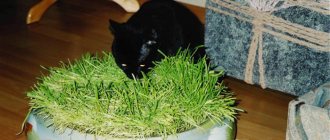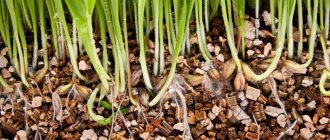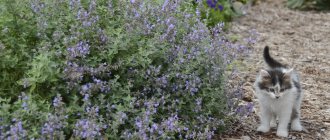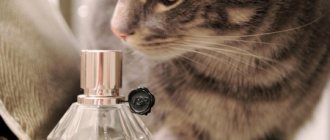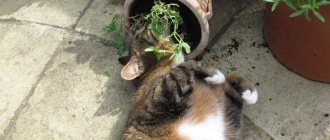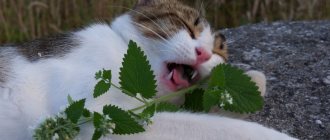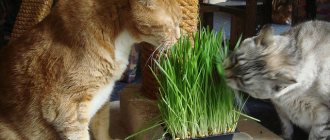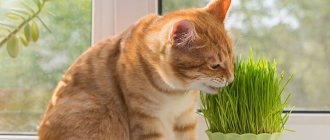Description of the plant Catnip
Catnip is very similar to common mint
A herbaceous plant reaching a height of up to 1 meter. It has a spreading, bushy crown. The shape of the leaves is oval-oblong, with pointed tips at the tips. When lightly rubbed, the leaves emit an attractive aroma because they contain a large concentrate of beneficial essential oils.
The plant attracts the cat family like a magnet not only with its smell, but also with its pleasant taste. Pets love to eat the leaves. In summer, the plant blooms in large and small inflorescences, which include a large number of small flowers.
The plant is a honey plant; its nectar attracts a huge number of insects.
Many beekeepers specially breed this species near their hives, and the finished honey has some zest, a bitterness. The color range starts from bright white and ends with lilac shades. The color depends on the plant variety, which includes more than two hundred species.
The dioecious plant, in appearance, resembles ordinary mint. This variety belongs to the fragrant, spicy plant species. Includes:
- Ascorbic acid.
- Essential oils.
- Tannins.
It has properties to repel annoying mosquitoes and small midges.
Catmint (Nepetia cataria) - what kind of plant is it?
Catnip - not all gardeners know what it is. But this is a herbaceous perennial, reaching a height of 1 m. It has several other names: lemon catnip, or catnip, which it received due to the increased attention of cats to fragile bushes.
Cats absolutely love catnip.
Short description
Catnip has a long, straight stem bearing heart-shaped leaves with serrated outer edges. It has small flowers of a violet or purple hue, and the smell has a distinct note of lemon.
For your information! The plant has many varieties, sometimes it is confused with lemon balm, but by the reaction of your pet you can easily determine which bush is in front of your eyes.
Anyone with a mustache can tell mint from lemon balm
What is the difference from regular mint
The main difference between the two types is the essential oils included in the composition. In peppermint or regular mint the base is menthol, in catnip it is nepetalactone. Another difference is the completely different aroma. The difference in smells is due to the same essential oil.
The varieties will not differ much in appearance, only the flowers will show their belonging to the crop.
Beneficial features
Veterinarians consider catnip, or catnip, to be a natural corrector that helps correct a pet’s behavior. Each animal reacts to it differently. There are several factors that make its use justified:
- in case of stomach cramps, the active components of the plant stop them, suppressing the vital activity of pathogenic microflora;
- in stressful situations associated with moving or long trips, a small amount of dry or fresh raw materials makes it easier for your pet to endure an unpleasant event;
- adding a small amount of dry catnip to food allows you to feed a handsome animal who refuses to eat; due to the components, the animal’s appetite sharply increases;
- the weed can be used to cleanse your pet’s gastrointestinal tract of worms.
Veterinarians consider the main advantage to be a mild psychotropic effect. Excitement or pacification after use lasts a short time and passes without harming the health of the animal. In any form it is not addictive or dependent.
Important! Dry raw materials are stored in hermetically sealed jars. Violation of the rules will lead to the evaporation of essential oils and loss of medicinal properties.
Catnip can be grown both in the garden and at home in a pot.
The benefit of weed is to help not only the animal, but also the person. The healing properties of the variety are used by both official and traditional medicine. It is used in the presence of the following factors:
- for attacks of migraine and headache;
- depression and apathy;
- hysterical fits and melancholy;
- spasms of internal organs, especially the digestive department.
Catnip helps normalize metabolism, activate the immune system, and lower blood pressure and glucose levels.
Difference from regular mint
The main difference from simple mint is the smell. Plain peppermint smells like menthol, while catmint smells like nepetalactone. A common person can only tell the difference if they rub the leaves with their fingers and then the difference is noticeable. But in cats, the smell reflexes are more developed than humans, and therefore, when passing by this plant, their nose smells the smell from a long distance.
Catnip is a favorite of cats
Cats perceive catnip as a medicinal herb. Many people have probably noticed their released pets mercilessly eating this plant. Cats especially react to lemon catnip, but unfortunately not all of them. Thus, cats produce some kind of treatment that calms the nervous system during periods of mass celebrations, and the herb is very beneficial for health.
What is catnip for? For a favorable life for your pets, especially at home, because many owners do not let their cats go outside.
Even if the animal has lost its appetite, if you add catnip to the food, the bowl will remain empty without food. A favorite of cats, it must be ingested by the animal 2 times a week. And in winter, when the vegetation falls asleep due to natural conditions, cats are given treats 3 times a week . We repeat once again that much depends on the animal itself and its genetic level. The main thing is not to overdo it, so that it does not turn from useful into contraindications.
KotemotFor those who love cats
This plant has many popular names: catnip, lemon catnip, cat grass... And also - cat drink, catnip, steppe mint, budra, field balsam, forest nettle, glushnyak, mint catnip, consumables, matinee, mine, shenda, matoshnik , magpie, fragrant horehound, catnip mint and even sore grass. But few people know that all these are different names for the same plant - Nepetia cataria. Why is she so attractive to cats?
Nepeta cataria is a perennial herbaceous plant from the Lamiaceae family, a close relative of peppermint. Many gardeners are familiar with this plant - large lush bushes, reaching half a meter in height, with characteristic peaked leaves. It blooms in June-July, pale lilac flowers are collected in characteristic bunches. The scientific name catnip comes from the name of the Etruscan city of Nepi, in the vicinity of which, apparently, many of this plant grew. Distributed in Europe, the North Caucasus, Western and Central Asia, Kazakhstan, Siberia, and the Far East. It grows everywhere - in fields and meadows, and even as a weed in fields and vegetable gardens.
Why is Nepetia cataria attractive to cats?
Catnip contains a special substance – nepetolactone. It is this that gives the plant’s essential oil a characteristic, very peculiar “lemon” smell. It is possible that the aroma of this substance for cats is similar to pheromones. This is why immature kittens are virtually immune to catnip. Moreover, even cats who love catnip are affected differently by the smell! Many owners know the calming, relaxing and restorative effects of the plant. This mint can be used to easily calm your cat while traveling or at the veterinary clinic. The plant will help you establish a relationship with your new pet, accustom it to a scratching post without stress, and introduce it to a new house or toy. At the same time, many people know the reverse specific effect of catnip, similar to a narcotic. After eating the plant, the cat rolls on the floor, meows, snorts, makes characteristic chewing and swallowing movements, and saliva may drip from its mouth. However, even this effect of catnip is harmless for animals, since it lasts only 15-20 minutes and does not cause addiction.
Do all cats love catnip?
Contrary to popular belief, not all of them. About 30% of adult pets are indifferent to it, just like immature kittens. And some highly excitable cats may behave aggressively after catnip. In this case, it is best not to give it to your pet anymore.
How often can you give catnip?
It is best to do this from time to time, and for no longer than 20 minutes. After 2 hours, you can again let your cat play with a temptingly smelling toy or pamper her with a delicious catnip treat. But it’s better not to do this every day. If used too often in large doses, the cat’s body gets used to the plant and over time simply stops responding to it.
What can you make from catnip?
The choice here is huge, for every taste and budget. From fresh and dried leaves, packaged in convenient bags, sprays to cat cosmetics, plant-filled toys and a variety of treats. You can also grow catnip yourself to delight your pet with fresh sprigs. This is not difficult to do: the plant is unpretentious, does not require special care and is resistant to temperature changes.
How to grow catnip yourself?
The plant is best planted in late May-early June. It can be sown immediately in the ground (but then the first shoots will appear only after 2 weeks) or planted as seedlings. The second method is more labor-intensive, since seeds for seedlings need to be sown in mid-March. The advantage of seedlings is that if you plant them in the ground with at least three or four leaves, you can get flowers this year. When sowing seeds directly into the ground, flowering will most likely only be achieved in the second year. Caring for catnip is quite simple: you need to plant it in well-loose, moist soil, loosen it regularly and water it. The plant does not require complex care, and it is also quite frost-resistant and drought-resistant. And if you want to get more lush and green bushes that will decorate your garden, you need to feed the flower on time. To do this, you can use both organic (such as humus or manure) and mineral fertilizers. Of course, growing a plant yourself is much more difficult than buying a bag of dried catnip at a pet store, but believe me, the trouble is worth it. But in general, it is not so important how catnip appears in your home. In any case, the pet will thank you for your care with its love.
Cat and catnip toy
How to use Catnip
Can be planted in a flower pot, in the country house, in the vegetable garden and gardens. Cats independently find this plant by smell and receive happiness hormones.
Make your own toy with grass sewn in and use it as a game with animals. Thus, a cat that spoiled shoes, furniture, tore wallpaper and much more will instantly switch to a new victim.
Many cats are difficult to train to a litter box. And catnip can really help with this problem. To do this, place a small sprig of mint under the tray. The animal will correct itself, stop shitting anywhere, and adapt to going to one specified place.
Cats have sharp claws. If we look at it on a larger scale, street cats wear them down naturally, but indoor cats have to grind them on new furniture and thereby spoil the interior. When buying an artificial claw sharpener, many animals simply do not react to the new fun and therefore, we recommend rubbing the machine with leaves. In less than a couple of minutes, the cat will begin to sharpen its claws where needed.
Many people prefer to buy ready-made houses for cats, but the animal does not stay there or even sleep, but simply avoids it. Then do this: use a store-bought spray and spray once. After which, the pet will definitely sleep and stay in the purchased house. You can sew a soft pillow and put dry dried catnip leaves inside.
Is catnip harmful to pets (cats)
Plant consumption should be in moderation
The plant has contraindications for cats:
Gradually, the nervous system may become exhausted, subject to constant eating. To protect your beloved pet from this fact, simply grow this type of plant in an inaccessible place. For example, you can use a summer house, or place a pot so that the animal cannot reach it.
It is not advisable to allow a cat to feast on this plant during pregnancy, as this can lead to termination or miscarriage of pregnancy.
Animals, like people, are all completely different and organisms are also different, and therefore, if you notice inappropriate behavior with aggression, then immediately abandon the plant and change it to another species. Otherwise, the animal may die or cause harm to humans and itself, being in a stupefied state.
Why cats don't react to catnip
Little kittens under six months of age do not react to catnip and there are reasons for this:
- The animal has experienced a stressful situation . For example, if a cat was transported by car or plane, then this is definitely stress, during which the animal stops responding to this plant. It is better to pamper your pet before the trip. Playful kittens up to six months do not need such stimulants for greater playfulness.
- Absence of a certain gene . The recorded fact is distributed to every third cat. There is no need to worry or sound the alarm, everything is fine with the animal, there is even nothing to doubt.
- If several cats live with you and there is a male among them, then you should give grass to each pet separately for the first time. This is done to check for aggressive behavior. An excited animal, capable of different actions. This can lead to a fight between all the animals in the house.
- If the cat has not reached puberty , then the reaction will be reduced to zero, and the smell will only push it in a different direction. Therefore, after puberty, you should choose the ideal plant for your pet.
Why does this plant attract cats?
As you know, nature has endowed cats with a keen sense of smell with a special sensitivity to essential oils. And therefore, it has long been no secret why they are attracted to this particular herb. Namely, nepetalactone contained in it, which affects the neurons of the animal’s brain. It is difficult to predict a cat's reaction. An active animal can behave calmly, while a passive animal can begin to behave violently. Subsequently, the pet’s type of behavior may change briefly and hallucinations may occur.
Typically, signs of exposure last between five and ten minutes. An interesting fact is that if a cat sniffs grass, the effect will be stimulating. But when taken in food, the effect will be sedative.
Sensitivity to the smell of catnip does not appear until the twelfth week of a kitten’s life. It must be remembered that some individuals may be completely indifferent to the catnip. According to statistics, this herb does not cause any reaction in 20–30% of cats. This is due to the lack of receptors that are transmitted at the genetic level.
Purposes and features of application
The most common use of catnip is to correct an animal's behavior . An aggressive pet can become docile and phlegmatic, while a lethargic one can become playful and active . Catnip is an excellent anti-stress product. It is recommended to give it to the animal when changing the environment, going to the doctor, etc. This way, its behavior will be calm. You can also add a couple of leaves to your food. This will be a good prevention against parasites and will help normalize digestion and appetite.
It is advisable to use the drug no more than once a week for 20 minutes . It can be in the form of dried weed, spray, fresh leaves or drops. If you wish, you can grow catnip yourself at home. Catnip seeds are available at any gardening store.
If you need to train your pet to use a scratching post, catnip will also come to your aid. This device will prevent damage to furniture and wallpaper. It should be placed near the sleeping place, since after waking up, cats first stretch and begin to sharpen their claws. In order to attract your pet’s attention so that he is not distracted by foreign objects while scratching, you need to rub the scratching post with catnip or put a bag of grass under the upholstery.
Read also: What does propolis tincture treat?
Advantages and disadvantages
The positive features of using catnip in animals include:
- anti-stress effect;
- harmless to the stomach;
- beneficial effect on the body;
- more agreeable behavior.
The disadvantages include a ban on frequent use, since this plant is a mild narcotic, and the cat may become addicted to it. And as a result, a defensive reaction is developed, that is, the pet will stop paying attention to it. It is not recommended to give grass to pregnant cats, as this can have a negative impact on the pregnancy of kittens due to irritation of the nervous system.
Where does catnip grow?
This species is found in many countries where there is a temperate climate. In forests on slopes, near water bodies, meadows and fields in the wild. In the Far East, the plant has adapted to the frosty climate. The central regions of Southern Europe are completely filled with different types of catnip.
In those places where wild cats live, grass grows especially well, so some prides of wild cat families, when moving, are always near the catnip. In South Africa, there are more than 100 plant species. India and Naples have about 80 species of catnip.
How to grow catnip at home
Emergence of plant shoots
At home, catnip is easiest to grow from seeds. Take a simple flower box and divide it into four parts, then moisten the soil, first make a depression up to 1 cm and place one seed in the holes at a distance of five centimeters from each other.
Then simply wet the surface of the soil. Next, put a transparent bag on the pot and wait for the first shoots to appear. Then remove the bag and continue to grow the plant in the usual way, observing the necessary conditions for rapid growth.
ADVICE: It is better to first germinate the seeds in a separate cup by wetting them, and then plant them in boxes. This method will give germination to full-fledged plants, and not to dummies that may not germinate. We also recommend keeping the seeds for about 10 minutes in a weak solution of potassium permanganate. This action will help initially prevent some transmitted diseases from the soil itself and protect against premature rotting of the root system.
After the first leaves appear, pick up the plant and replant it in flower pots. Pinching the root system is a mandatory procedure that will allow the plant to grow wider and not upward. This is a kind of handmade decoration.
As the plant grows, it should be replanted annually into larger pots. This will allow the catnip root system to develop better and be nourished by the properties of the soil composition itself.
Regular watering is required as needed, because in hot room temperatures, the soil can dry out literally within 12 hours. In order not to miss the moment of watering, make a tray for the pot into which you simply add water. The plant itself will take the amount of water that is needed and at the same time reduce constant care significantly.
It is also necessary to form a catnip. After flowering, it is necessary to cut off protruding side shoots and leaves. This will not only give a beautiful appearance, but will also eliminate diseased, inconspicuous areas of the plant. The magic bush will begin to develop many times faster, which will allow you not to miss a tasty treat for your cats.
It is necessary to fertilize, preferably with mineral fertilizers. This is done during germination, then before flowering and during flowering when the buds open, because all the nutrients are transferred to the flowers, and the root system is simply depleted during these periods. This manifests itself in underdevelopment of the plant, the appearance of curvature and a decrease in the size of the leaves.
Growing catnip in your garden
Planting work is carried out in several stages.
Purchasing or selecting seed material
If you want to plant bushes on your garden plot, you need to find good quality seedlings or grow them yourself. First you need to decide on the type of catnip. Many varieties tolerate both hot weather and winter cold.
The purchase of seedlings is carried out in specialized nurseries or garden centers - places of professional cultivation of crops. When purchasing, you need to pay attention to the condition of the seedlings. They should not show signs of mechanical damage or disease. Healthy foliage is smooth, grayish-green in color and without whitish or yellowish spots. The soil in the pots should be free of foreign impurities and sufficiently moist.
Selection of future planting sites and soil preparation
Catnip develops best in well-lit areas with free access to sunlight. Some varieties do well in partial shade. The site should be located on a hill; lowlands and close groundwater will lead to rotting of the root system. There should be no tall crops near catnip, as it requires a large space.
Preference is given to loose, light and fertile soil types. Preparatory work begins in the fall: the area must be dug up to the length of a shovel bayonet. Fertilize the soil with a mixture including:
- humus - 3 kg;
- ammonium nitrate - 20 g;
- superphosphate - 30 g;
- Potassium sulfate - 10 g.
Important! After adding nutrients, the soil is carefully dug up.
Planting in open ground
Preparatory work begins after the snow melts and the soil warms up. The pre-selected area is dug up again and leveled. Seedlings or young seedlings are watered abundantly, this will help them to be easily removed from containers.
Small holes are dug in the area, the distance between them is maintained at least 30 cm. When planting tall varieties, it is increased to 40-50 cm. It is important to remember that mint can grow strongly under favorable conditions.
A small amount of river sand is poured into each hole as a drainage layer. The seedlings are carefully removed from the boxes so as not to damage the root system and planted in prepared holes.
Catnip grows well in open ground and quickly fills the area
Important! After finishing the work, all the bushes are watered, and the ground around the bushes is mulched with peat.
Further care
Caring for catnip is easy:
- Watering is required moderate and rare, from 1 to 2 times a month. This species is drought-resistant and is not afraid of slight drying out of the ground;
- loosening is carried out several times a season; it provides the root system with access to fresh air. Also, at the same time, add a small amount of mulch;
- fertilizing includes the application of mineral fertilizers: before the formation of buds, and then only after pruning;
- The bush does not respond well to pruning, but if its shoots are reduced by half, you can expect re-blooming in the autumn months.
Note! If the stems have been reduced by more than 50% during pruning, the mint is at risk of freezing in the winter.
Covering the bushes is carried out in the absence of snow. It is enough to take spruce, pine spruce branches or fallen leaves. Catnip is a frost-resistant species; if there is enough snow, it does not need additional protection.
